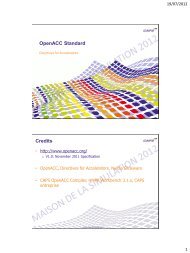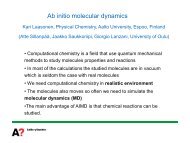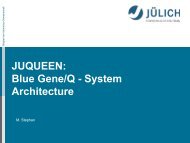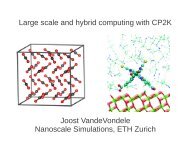Molecular Simulation Methods with Gromacs
Molecular Simulation Methods with Gromacs
Molecular Simulation Methods with Gromacs
Create successful ePaper yourself
Turn your PDF publications into a flip-book with our unique Google optimized e-Paper software.
BackgroundIn this tutorial, we’ll calculate the free energy of solvation of a small molecule:ethanol. This type of calculation can either be done on its own, or can be part of abinding free energy calculation. Such calculations can be important, because the freeenergy is the most important static quantity in a thermal system: its sign determines thewhether of a molecule will be soluble, or whether it will bind to another molecule.We will start this tutorial <strong>with</strong> some background on how to calculate free energies,and how a free energy of solvation relates to a free energy of binding calculation. Then,we will focus on the practicalities of doing such a calculation in <strong>Gromacs</strong>. You will need<strong>Gromacs</strong> 4.6 (or later) for this tutorial.Calculating a free energy of bindingCalculating free energies can usually only be done using small steps and a full pathbetween one end state and the other. For example, to calculate the binding free energyof the ligand to a protein, we ultimately need to compare the situation of the ligandbeing bound to the protein, to the situation where both the ligand and the protein areseparately in solution:LPGLPThis could be calculated directly, for example by dragging the ligand away from theprotein and integrating the potential of mean force (averaging the force, and integratingit). Forces have very large fluctuations, however, and this turns out to be much moreexpensive than using free energy perturbation methods such as the Bennett AcceptanceRatio (BAR) we’ll use in the tutorial.Remember that a free energy difference between two states A and B determines theirrelative probability p A and p B ,p A= exp F B F Ap B k B Twhere k B is Boltzmann’s constant relating thermal energy to the temperature (1.38·10 -23J/K), and T which is the temperature. We could, in principle, calculate a free energydifference by waiting long enough, and measuring how often the system is in which1
















